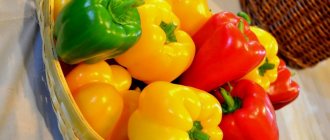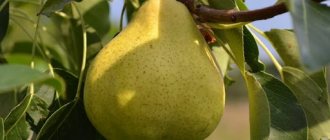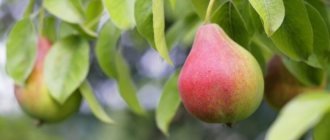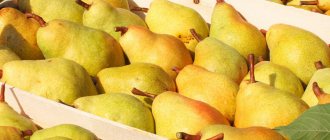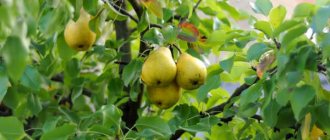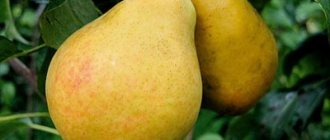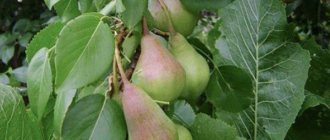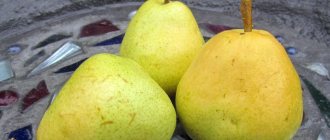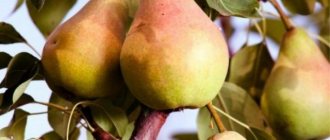Determination of fruit ripeness
Each variety has its own timing of fruit ripening. But these terms are influenced by the climatic characteristics of each region, the amount of precipitation, care and composition of the soil. The main signs of pear ripeness are appearance and taste. They also take into account the average ripening time of a certain variety in their region.
The main features include:
- Skin color. During ripening, it turns from green, yellowish or with red barrels, it all depends on the variety.
- Easy to remove. The stalk is easily removed from the branch.
- The firmness of the skin disappears and a slight softness appears.
- Changes in seeds. It is made brown or brown in color.
- Smell. A ripe pear has a fragrant smell.
It is also important to consider the timing of last year’s harvest. If the summer is hot and dry, then the fruits ripen faster, and at cool temperatures, on the contrary, slower. Therefore, weather conditions are taken into account first.
On a note!
The harvest period lasts from 3 to 7 days. During this time, as the pears mature, they are harvested. If there is no way to stretch out the collection, then everyone is collected. Hard fruits ripen after a couple of days of lying.
But despite all the conditions, the same variety on different trees can ripen differently. This is influenced by the conditions for placing the tree, lighting, soil composition and density of the garden. The timing is also affected by the quality of care, how timely the fertilizing is done and the trees are treated against diseases and pests.
What affects the ripening of pears
Of course, determination by appearance and taste always works, but it does not always provide reliable information. External factors also influence the harvesting time. In Russia, weather conditions differ every year from previous ones, so it is difficult to determine the exact time. For example, unlike Russia, in California the weather is stable, so it is easy to calculate the relationship between ripening and flowering.
The duration of ripening of fruits of the same variety growing in the same area is influenced by:
Might be interesting Pear "Simply Maria". DescriptionHow to properly trim and shape a pear in spring: a guide for beginnersWhat is pear worm and measures to combat it
- late onset of spring;
- illumination;
- damage to wood during frosty winter;
- hot or cold summer;
- soil composition;
- amount of watering and rain;
- pest attack;
- more susceptible to disease;
- amount of fertilizing;
- rapid ripening of fruits along the periphery, slow inside the crown;
- number of fruits on the tree.
If the same variety is grafted onto different rootstocks, the pears ripen unevenly. The same applies to harvesting the same variety in different regions of the country.
Stages of fruit ripeness
There are several stages of pear ripeness. Depending on the purposes of further use, one of the stages is chosen. The fruits are used for food, processing or storage. If the fruit is picked at the wrong stage, it will spoil. Therefore, for long-term storage, for tasty juice or jam, you need to understand how the stages differ from each other.
Methods
How to preserve pears longer for the winter? There are several ways to store pears:
- in cellars and basements (details in the article “Storing pears in the cellar”);
- in an apartment (more details in the article “Storing pears at home”);
- in plastic bags;
- in jars in the form of preparations for the winter;
- frozen (for details, see the article “Freezing pears for the winter at home”);
- in dried and dried form (for more details, see the articles “Drying pears for the winter” and “Drying pears for the winter at home”).
Harvesting Rules
There are certain rules according to which you can properly harvest pears. For storage and processing of fruits, the following recommendations are followed:
- Do not squeeze or drop fruit. It is not recommended to knock fruits from the tree.
- Harvesting begins from the lower branches, gradually moving to the upper ones.
- The work is done with gloves. This way the natural coverage is preserved.
- Remove the pear from the branch by gently rotating it.
- The baskets or buckets where the collected fruits are placed are covered with burlap.
- Damaged or infected fruits are placed in a separate basket.
- It is best to harvest in the first half of the day, before the pears have warmed up in the sun. Otherwise, the fruits are cooled before storing.
Tall trees are more difficult to harvest. In this case, use a special device - a fruit picker. It is made from scrap materials (for example, a plastic bottle, which is cut and attached to a stick) or bought in a store.
Real reviews
There are 6 pear trees growing on the dacha plot. I can’t say for sure which variety they belong to. However, compared to last year, 2021 brought a good harvest. My husband and I were able to collect fruit not only for food and canning, but also for preparing wine drinks: cider, wine.
- Tamara Vasilievna, 59 years old
I got my pear from my mother. The tree has been growing on the site for more than 50 years. I determine when to remove pears for storage by the color and fall of the first fruits. As soon as two or three fruits have fallen off, I completely tear off the fruit tree, setting aside unripe fruits for ripening. In 2021 I hope for a good harvest, since last year was “poor”.
Source
Fruit harvesting dates
First, they determine for what purpose the pear harvest is taking place. For example, early varieties ripen early and are not intended for long-term storage. And the later ones are not consumed immediately after collection; they need time to rest. If harvesting is not done in a timely manner, the quality of the fruit will deteriorate. According to the harvesting time interval, summer, autumn and late winter varieties of pears are distinguished. They differ from each other in terms of harvesting time, storage conditions, processing and consumption.
Summer varieties
These varieties ripen in early August; they are not intended for long-term storage and are consumed immediately. Since the fruits ripen unevenly, they are picked in several stages. This harvest period is characterized by dark seeds, and the fruit is easily removed from the branch. The aroma and color correspond to the parameters of the variety.
On a note!
In case of calm weather, several fruits have fallen from the tree, which means it is necessary to urgently collect the entire harvest. Even if the pears are whole and have not been attacked by pests or diseases.
The fruits of the summer harvest do not last long. The maximum number of days during which they do not spoil is 15 days. There are exceptions in the form of several varieties that can be stored for up to one month. As a rule, summer varieties are processed immediately, since they do not have time to eat everything. For processing and harvesting, pears are removed at the technical stage of ripeness.
Autumn varieties
I collect these varieties at the end of August and throughout September. Autumn varieties are divided into early and late. The former are more classified as summer varieties, while the latter are more winter varieties. Early autumn ones are removed when the maturity or consumer stage begins. Fruits can be stored for up to two months and eaten immediately. If it needs to be processed, it is collected at the technical stage.
Late autumn varieties are harvested at the botanical stage. They are not eaten immediately, but are allowed to sit for 2 to 4 weeks. They can be stored for up to 3 months. Due to the fact that such varieties can sit for a long time and not deteriorate, they are not allowed for processing. Only at the request of the gardener.
Late winter varieties
These varieties are collected at the end of September. The main thing is to do it before frost sets in. If the fruits are caught by a slight frost, they will not be able to be stored for long. To use winter varieties for food, they are allowed to rest for up to four weeks. If consumed untimely, you may not be able to taste the taste and aroma of the variety. If stored correctly, pears will last for 5-6 months.
How to store
Before placing pears in storage containers, they are carefully inspected. The fruit must have a stalk, the skin of the fruit must remain intact. Fruits with mechanical damage or traces of insects are sent for processing. Pears at home can be stored in the vegetable department of the refrigerator, in cool conditions in the pantry, in a cold cellar or basement.
If a technical room with shelving is selected for storage, it is pre-prepared - the walls, ceiling, flooring are disinfected, and the shelves of the shelving are treated. The required temperature regime is created in the room (from +1 °C to +4 °C), air humidity is maintained within 80-90%. At low humidity, fruits will begin to lose moisture at an accelerated pace. The room must be ventilated.
How to keep it fresh for a long time
Whole, well-preserved pears are placed in boxes in a vertical position. The stalks should remain at the top of the fruit. The pears are placed on the bases of the fruits; the dried petals of the inflorescences are left on them in a residual form. Containers without lids for storage must be dry, clean, and have small ventilation holes in the walls.
The method of laying pears in boxes depends on the height of the side walls. If the walls allow them to be placed in two rows, then the layers are sprinkled with dry straw or shavings. If fruits are stored at home not in boxes, but in bulk on racks, then they are also placed with their tails up, and straw or shavings are scattered between the fruits.
Pear picking depending on the region
When choosing a variety for cultivation, it is important to consider the climatic conditions of your region. Since, regardless of the taste, immunity and productivity of one variety planted in one region, it will not produce many fruits in another.
- Middle lane. In the central region (directly in the Moscow region), varieties of late pears take root well. They are collected from the end of August to the end of September. Fruits collected in the middle zone are stored for 4 to 6 months.
- Southern part of the country. In this part the fruit tree feels comfortable. Harvest occurs in the last days of summer and the first days of September.
- Siberia and the Urals. For cold regions, it is important that the variety is able to withstand winter frosts. The pear harvest in Siberia falls in the second half of August - the end of October.
But before you start harvesting, it is necessary to accurately determine their maturity so as not to spoil the taste characteristics of the fruit. It is not worth picking pears at once, since their stages of ripeness are not the same, even if they grow on the same tree.
The rules for picking pears, especially late varieties, are simple. If you adhere to them, you can avoid major mistakes and keep the harvest intact until winter. The main thing is to choose the right time for cleaning. This will require the attentiveness of the gardener and the experience of harvesting from previous years. You should not leave summer varieties for storage, or, conversely, try to eat winter ones. The rules for each variety must be followed.

